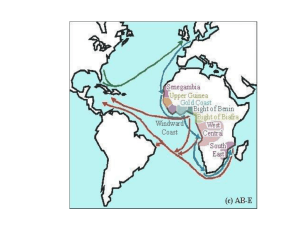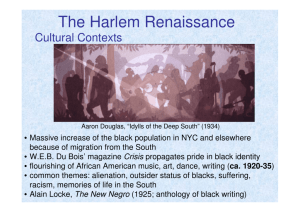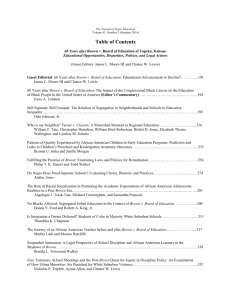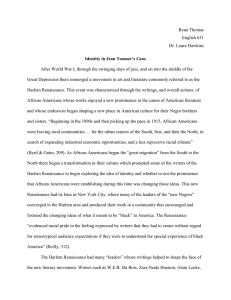From Classical to Contemporary
advertisement
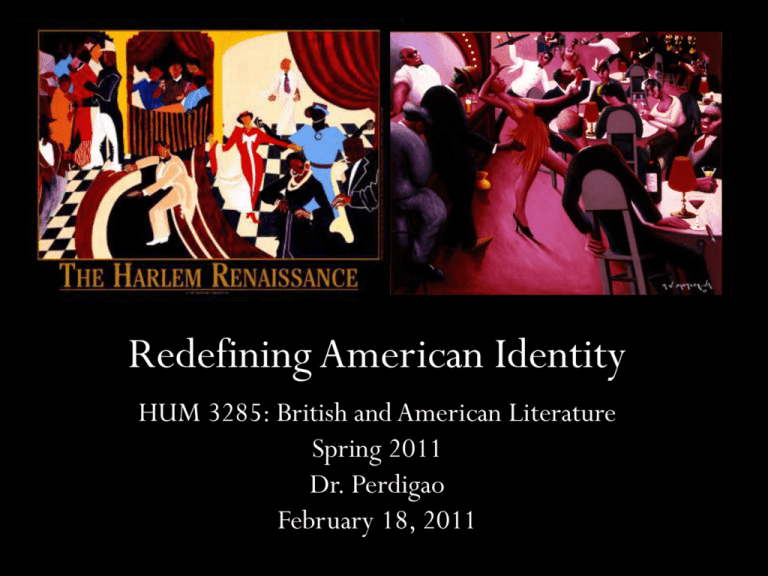
Redefining American Identity HUM 3285: British and American Literature Spring 2011 Dr. Perdigao February 18, 2011 Race and/in America • 1526: 100 African slaves brought to North American continent • 1619: Jamestown, Virginia colony established with twenty Africans as indentured servants • 1645: Trade in African slaves begins in Boston, becoming triangular trade between North/South America, Europe, and Africa • 1705: Slave code defines slave status: all Negro, mulatto, and Indian non-Christians • 1740: Comprehensive “Negro Act” denies slaves basic freedoms, including the right to read • 1760: Narrative of the Uncommon Sufferings and Surprizing Deliverance of Briton Hammon, first dictated slave narrative in America • 1773: Phillis Wheatley’s Poems on Miscellaneous Subjects, first book published by a black slave in America Race and/in America • 1775: First anti-slavery society organized in Philadelphia • 1776: Colonies declare independence from Britain; Continental Congress votes against the importation of slaves in all thirteen united colonies • 1793: First Fugitive Slave Act • 1808: African slave trade officially ended in Britain • 1816: American Colonization Society founded in Washington, DC to return freed slaves to Africa • 1830: International salve trade officially ends; illegal traffic continues • 1830-60: Slave narratives become the most popular form of American literature • 1831: Nat Turner’s revolt in Virginia; Underground Railroad • 1833: Oberlin College founded as first coeducational, racially integrated US college Race and/in America • 1839: Amistad revolt led by Joseph Cinque, carried out by fifty-three Africans • 1845: Narrative of the Life of Frederick Douglass, an American Slave, Written by Himself • 1850s: Hannah Crafts’ The Bondwoman’s Narrative, first novel by an African American woman; Congress passes second Fugitive Slave Act; fugitive slave hunts • 1852: Harriet Beecher Stowe’s Uncle Tom’s Cabin; or, Life among the Lowly • 1853: William Wells Brown’s Clotel, or the President’s Daughter, first known African American novel • 1857: Dred Scott decision—denial of access to federal courts • 1861-65: American Civil War • 1861: Harriet Jacobs’ Incidents in the Life of a Slave Girl • 1862: Emancipation Proclamation abolishes slavery Race and/in America • 1865: 13th Amendment passed, freedom to former slaves; Freedmen’s Bureau and Freedmen’s Bank; Ku Klux Klan formed in Tennessee; assassination of Lincoln • 1866: Civil Rights Act—citizenship for all Americans • 1867: Howard University founded in Washington, D.C. for former slaves; Reconstruction begins • 1868: 14th Amendment passed, granting African American citizenship and civil rights • 1870: 15th Amendment passed, giving African American male citizens the right to vote • 1877: Reconstruction ends • 1881: Booker T. Washington founds Tuskegee Institute in Alabama • 1883: Supreme Court repeals Civil Rights Act of 1866 Race and/in America • 1896: Plessy v. Ferguson Supreme Court case upholds separate but equal doctrine • 1901: Booker T. Washington’s Up from Slavery • 1903: W. E. B. Du Bois’ Souls of Black Folk • 1909: NAACP founded • 1910-30: Great Migration of African Americans from South to North, second African Diaspora • 1910: The Crisis NAACP journal founded; anti-lynching campaign begins • 1915: Death of Booker T. Washington; Association for the Study of Negro Life and History founded • 1919: “Red Summer” of more than eighty lynchings and twenty-five race riots; McKay’s “If We Must Die” and Hughes’ “The Negro Speaks of Rivers” Race and/in America • 1920: 19th Amendment gives women right to vote; Prohibition begins; Marcus Garvey’s First International Convention of the Negro Peoples of the World leads to the Universal Negro Improvement Association (UNIA) for racial solidarity and return to Africa; the New Negro (Harlem) Renaissance begins • 1923: Toomer’s Cane • 1925: Alain Locke’s The New Negro, anthology of Harlem Renaissance • 1926: Hughes’ The Weary Blues and “The Negro Artist and the Racial Mountain”; Nella Larsen’s Quicksand; Negro History Week established • 1928: McKay’s Home to Harlem; Larsen’s Passing • 1933: New Deal legislation; WPA (Works Progress Administration) begins, giving support to writers and artists • 1937: Hurston’s Their Eyes Were Watching God (The Cambridge Companion to the African American Novel. Ed. Maryemma Graham. Cambridge: Cambridge UP, 2004.) Harlem Renaissance • Beginnings in 1914, 1927, spanning 1923-1929 (Heath 1741), even 1895 with Booker T. Washington’s address • Colored American Magazine, founded in 1900 • Crisis magazine, established in 1910 for the National Association for the Advancement of Colored People (NAACP) • W. E. B. Du Bois, essays on art and culture, running Crisis, with editor Jessie Fauset • Charles S. Johnson, editor of Opportunity • Cultural identity, psychological reconstruction, intellectual responsibility as themes in Harlem Renaissance writing • Alain Locke’s The New Negro, progressive views of writer in black America • “talented tenth” Reconstructing a tradition • Social realist or “protest novel” or impressionism or high modernism • Ideas about culture and cultural transmission • Recovery and revision of the canon • African-derived oral forms and traditional Western literary forms • Uses of the folktale, slave narrative, the blues • Questioning place of tradition—cultural continuity, innovation, radical change • “The continuous need to explain and ‘inscribe the self’ in a world which has historically denied the existence of that self gives both focus and intensity to the act of writing a story about black life” (Graham 5). • Writing as act of cultural revisionism, redefining history and historical memory, confronting the past Jean Toomer (1894-1967) • Poet, dramatist, novelist, essayist, and philosopher • Born in Washington, D. C. • Grandfather was former lieutenant governor of Louisiana during Reconstruction; raised by grandparents after the death of his mother • Dedicated Cane to his grandmother • Attended University of Wisconsin, the American College of Physical Training in Chicago, the University of Chicago, and New York University; entered University of Wisconsin passing for white • Changed name from Nathan Pinchback Toomer to Jean Toomer in 1920, after reading influential texts • Moved to Georgia in 1921 to be acting principal at the Sparta Agricultural and Industrial Institute; Toomer in the South twice, for less than three months • Defined self as American rather than African American Structuring • • • • Three parts of the novel First part—southern women, image of sun, changes to slave system, victims of caste Second part—northern cities, cut off from others, loss of spirituality Third part—dramatic narrative • “Blood-burning Moon” as end of first section of Cane, only story staging confrontation between races • Not a woman’s name • Louisa, Tom Burwell, Bob Stone • Moon as character, taking part in the tragedy • William M. Ramsey’s “Jean Toomer’s Eternal South” • Two Souths—historical oppression and lack of progress and “eternal South” as site of culture Reading Race • “points to a cosmic order detached from blind and earth-bound human passions” (Ramsey 87) • The South giving Toomer an identity, liberating him from the loss of spirituality in modernism • Jennifer D. Williams’ “Jean Toomer’s Cane and the Erotics of Mourning” • Battle over masculinity rooted in the economics of slavery (Williams 95) • Lynching—protection of white womanhood, here over a black woman • White men’s rape of black women as other story • Male/female, light/dark, North/South, black/white, urban/countryside, narrative closure/fragmentation (Heath 1743) Zora Neale Hurston (1891-1960) • Born in 1891 in Alabama, fifth of eight children; family moved to Eatonville, first incorporated black community in America; father as mayor • Attended Howard University; graduated from Barnard College, studying with Franz Boas • Short story “Spunk” published in Locke’s The New Negro • Collecting folklore in Florida, Mississippi, Louisiana • Returns to Eatonville in 1927 during Great Migration under fellowship from the Association for the Study of Negro Life and History • Folklore collection Mules and Men (1935); novels Jonah’s Gourd Vine (1934), Their Eyes Were Watching God (1937); Moses, Man of the Mountain (1939); autobiography Dust Tracks on a Road (1942) • Mules and Men as first collection of black American folklore by African American • Death in poverty, burial, headstone by Alice Walker Zora Neale Hurston (1891-1960) • Wrote Mules and Men in Eau Gallie and Their Eyes Were Watching God in Haiti while on Guggenheim fellowship doing ethnographic research • Worked for the WPA writing sections on folklore for volume on “The Florida Negro” • Changes in landscape for fiction with Native Son, ideas about the protest novel • Idea of preserving and adapting cultural practices versus creating in the dominant style of the time • In 1950s, moved back to Eau Gallie • Scandal with writing to editor of the Orlando Sentinel criticizing ruling in Brown v. Board of Education • Dies in Fort Pierce, in a welfare home • 1960s and 1970s, resuscitation of Hurston’s works Gildings • Double-voiced narration • Inside/outside perspectives • Missie May and Joe • “But there was something happy about the place” (1839) • Otis D. Slemmons—from Chicago • “Hes jes’ got a corperation. Dat make ‘m look lak a rich white man” (1841). • Moon, sun • Gilded half dollar Langston Hughes (1902-67) • Hughes born in 1902 in Joplin, Missouri to stenographer father and mother who wrote and acted • Father left for Cuba and then Mexico; failed reconciliation with mother; Hughes lived in Kansas with his working mother; after grandmother died, lived with mother in Illinois • 1916: Hughes named class poet at Ohio school • 1918: Published verse and short stories in Central High Monthly Magazine • 1919: Spent summer with father in Mexico; lives with him for a year • 1921: Hughes published “The Negro Speaks of Rivers” in The Crisis; enrolled in Columbia University; met Fauset, Du Bois, Cullen • 1922: Withdrew from Columbia; continued to publish • 1923: Wrote “The Weary Blues” after visiting a Harlem cabaret Langston Hughes (1902-67) • 1923: Visited Africa while sailing on steamship • 1924: Settled in Paris; influence of jazz • 1925: Lived in Washington, DC with mother; won Opportunity magazine’s poetry prize for “The Weary Blues” • 1926: Entered Lincoln University • 1927: Met patron Charlotte Mason (“Godmother”); traveled with Hurston who was also supported by Mason • 1929: Graduated from Lincoln; completed first novel • 1930: Visited Cuba; Hughes broke with Mason, Hurston, Locke • 1931: Traveled to Haiti and in 1932 and 1933 Moscow • 1940: published autobiography The Big Sea in same year as Richard Wright’s Native Son Langston Hughes (1902-67) • 1942: Worked for war effort on projects for the Office of Civil Defense and Writer’s War Committee • 1944: FBI surveillance of Hughes for alleged communist activity; attacked by Special Committee on Un-American Activities of the House of Representatives • 1948: Hughes denounced as a communist in the U.S. Senate • 1953: Served subpoena to appear before Senator McCarthy’s subcommittee on subversive activities; was exonerated but attacks continued • 1961: Inducted into the National Institute of Arts and Letters • 1967: Died after illness, prostate surgery

